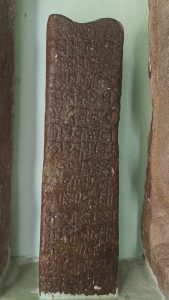Science
Epigraphic Discovery Reveals Insights into Chindaka Naga Dynasty

A significant archaeological breakthrough has emerged from the Jeypore Museum in India, where epigraphist Bishnu Mohan Adhikari recently deciphered an undocumented inscription on a stone pillar. This finding sheds new light on the history of the Chindaka Naga dynasty, a powerful ruling clan in the 11th century, and enhances our understanding of the southwestern region of Odisha and the adjacent Chakrakota area in present-day Chhattisgarh.
During his visit to the museum, Adhikari, accompanied by his colleagues Sarat Routray and Himansu Sekhar Sadangi, uncovered a previously overlooked stone pillar. This pillar, measuring approximately 7 feet 4 inches at the base and standing 26 by 7 inches high, had remained unnoticed since the museum’s establishment in 1976 by IAS officer Jiban Pani. Following authorization from museum officials, the team created an estampage of the 16-line inscription, which presents a valuable glimpse into the past.
The pillar, originating from the Bhairabsinghpur-Kumli-Kamta region of the Indravati valley, features both an inscription and an erotic engraving of an ass and a pig, motifs that Adhikari noted are also found in other inscriptions associated with the same dynasty. The inscription itself contains a Raja Prasasti—a royal eulogy—honoring a Chindaka Naga king, identified by the title Madana Nrpa kula kamala bhaskara tilaka. Although some lines are illegible, Adhikari suspects additional text may be hidden beneath the concrete base of the pillar, suggesting that the current inscription is incomplete.
This inscription is attributed to the Nagavanshi rulers of Chakrakota, who dominated the Indravati river valley and parts of Kalahandi and Koraput during the 11th century. Adhikari noted parallels with similar inscriptions from the reign of Someswara Deva (1069-1110) in the Kuruspal region of Chhattisgarh, emphasizing the historical significance of the findings. The language of the inscription is a corrupted form of Sanskrit using Odra Nagari characters, which closely resemble the early forms of the modern Odia script. Key words such as Bikantha Sri Karana, Kasa Dasa, and Damodara reflect distinctive Odishan writing styles, indicating that this inscription may represent one of the earliest examples of the evolving Odia script from the Koraput region.
The discovery has resonated within the academic community, with Dr. Raj Kumar Rate, a lecturer in history at Khariar Autonomous College, describing it as a “monumental finding for Odisha.” He pointed out that this inscription is the first of its kind from the Chindaka Naga dynasty discovered in Odisha, making it the oldest inscription from present-day Koraput district. This finding predates the Khechela copper plate grant from Raghunath Krushna Deva of the Surya Sankara dynasty.
Historically, the Naga dynasty is recognized as one of the early ruling clans in India. In the Koraput region, the Chindaka Nagas gained prominence following the Nala dynasty, with their governance in Chakrakota supported by the Somavanshi rulers Janmejaya and Udyotakeshari. The Chindaka Nagas were known to have allied with the Eastern Gangas during conflicts with the Kalachuris of Ratnapur.
This newly deciphered inscription is poised to illuminate the political and cultural landscape of the tribal-dominated regions of the Koraput district and the Bastar region of Chhattisgarh, providing essential insights into 11th-century India. The ongoing research and investigation surrounding this finding will likely further enrich the historical narrative of the area, connecting contemporary residents with their ancestral heritage.
-

 World4 months ago
World4 months agoSBI Announces QIP Floor Price at ₹811.05 Per Share
-

 Lifestyle4 months ago
Lifestyle4 months agoCept Unveils ₹3.1 Crore Urban Mobility Plan for Sustainable Growth
-

 Science3 months ago
Science3 months agoNew Blood Group Discovered in South Indian Woman at Rotary Centre
-

 World4 months ago
World4 months agoTorrential Rains Cause Flash Flooding in New York and New Jersey
-

 Sports3 months ago
Sports3 months agoBroad Advocates for Bowling Change Ahead of Final Test Against India
-

 Top Stories4 months ago
Top Stories4 months agoKonkani Cultural Organisation to Host Pearl Jubilee in Abu Dhabi
-

 Science4 months ago
Science4 months agoNothing Headphone 1 Review: A Bold Contender in Audio Design
-

 Top Stories4 months ago
Top Stories4 months agoAir India Crash Investigation Highlights Boeing Fuel Switch Concerns
-

 Sports3 months ago
Sports3 months agoCristian Totti Retires at 19: Pressure of Fame Takes Toll
-

 Business4 months ago
Business4 months agoIndian Stock Market Rebounds: Sensex and Nifty Rise After Four-Day Decline
-

 Politics4 months ago
Politics4 months agoAbandoned Doberman Finds New Home After Journey to Prague
-

 Top Stories4 months ago
Top Stories4 months agoPatna Bank Manager Abhishek Varun Found Dead in Well









